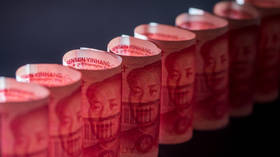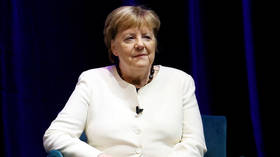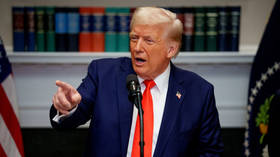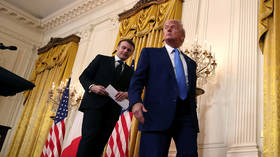China hints at its asymmetric warfare system aimed at dethroning US dollar

Barely a day goes by without a headline about the Chinese yuan gaining further traction in global trade. As de-dollarization gains steam, the currency of the world’s second largest economy has been thrust into the spotlight.
The dollar paradigm assumes any serious currency must be supported by a framework of full financial liberalization and open and deep capital markets. The greenback’s extensive liquidity is also underpinned by massive US deficits – dollars flowing out to the world – making one wonder if the system as we know it could even function if the world’s chief currency didn’t belong to a country with chronic trade deficits.
China has made internationalization of the yuan a stated policy objective – and it has gone some ways toward integration in the global financial system. However, it has resisted the type of liberalization that could significantly elevate its status as a reserve currency.
In recent years, it has become increasingly apparent that China seeks not to carve out for the yuan a bit more room in the current Western-led system – or even dethrone the dollar and install the yuan in its place – but to create ‘from the ground-up’ the financial infrastructure that insures national sovereignty and protection from the vulnerabilities of the increasingly mismanaged dollar-based system. And it hardly needs mentioning that China is far from alone on this path.
There was a time when it seemed that the yuan was on an inexorable path toward becoming something akin to a junior partner of the dollar in the US-led ‘rules-based’ order. China’s accession to the World Trade Organization in 2001 prompted a wave of US investment in Chinese factories. In 2007, historian Niall Ferguson and economist Moritz Schularick coined the word ‘Chimerica’ to describe the symbiotic relationship between the two countries. The hope at the time in Western capitals was that China would nicely enter the Western financial orbit.
And indeed, the yuan’s scope was widening. By 2015, it had become the fifth most used currency globally, and in 2016 it was given a stamp of approval from the high priests of global finance – the IMF – which added it to its special basket of global currencies (SDRs) used for lending to sovereign borrowers.
The word Chimerica isn’t heard much these days and, while China remains a member of the Washington-led IMF, it’s hardly a priority in Beijing these days.
What happened?
The answer to this question requires a brief detour. Being dependent on somebody else’s currency – as has been the case for most everybody under the dollar system – opens you up to two types of vulnerabilities: market and political.
The first is well known and is as old as the system itself. For emerging markets in particular it essentially means having to manage two currencies: One hand needs to be kept on the lever of the domestic currency and the other on FX reserves. Meanwhile, if the dollar strengthens or if US rates rise, trouble can quickly ensue, especially if the central bank has to deplete reserves defending the national currency. But what if the opposite happens and the US in a state of imperial decline debauches its own currency? For those facing the prospect of the actual value of their dollar holdings declining – such as against commodities – this is of no small concern.
This is hardly a fantastic scenario. In fact, the financial crisis of 2008-2009 provided something of a preview of how this could eventually play out. To shore up the economy in the wake of the crisis, the US printed a hitherto unimaginable number of dollars. It is certainly no coincidence that merely days after Fed Chair Ben Bernanke announced the largest money-printing escapade in history, in March 2009, the head of the People’s Bank of China issued a not very subtlety titled white paper called ‘Reform the International Monetary System’.
Although the Washington elite is accustomed to acting with impunity regarding the dollar – “our currency, but it's your problem” as John Connally, a US Treasury secretary in the 1970s, once put it – such massive money creation is a sensitive point for the Chinese, which had accumulated massive dollar-denominated reserves, largely in Treasury bonds, since its accession to the WTO in 2001.
The Chinese authorities seemed to have realized that their dependence on the dollar had become a significant risk. The prospect that an increasingly dysfunctional US could debauch the currency could no longer be ignored. J. Paul Getty once quipped: “If you owe the bank $100 that’s your problem. If you owe the bank $100 million, that’s the bank’s problem.” In this case, China is the bank and the US is the debtor, and this is very much China’s problem.
If 2008-09 showed the US had no qualms about printing as much as it needed to put out domestic fires, a few years later it would have no qualms about using the financial system as a weapon to advance its geopolitical aims – even against a major world power. And this is where the second element comes in: the political risk. This was new but it absolutely began to change the calculus for everybody. If a debauched dollar was a distant risk, being cut off from one’s dollar holdings for having looked cross-eyed at Washington was a new and very material risk.
A US-engineered coup in Ukraine in 2014 and installation in Kiev of a puppet government hostile to Russia triggered Moscow’s subsequent reunification with Crimea and backing of Donbass rebels. As a result, shortly thereafter and in the ensuing years, Russia was hit by increasingly stringent sanctions for each alleged misstep – and sometimes for no reason at all.
Observing these events and quietly drawing their own conclusions were the Chinese. Not long after Crimea, something odd happened: The internationalization of the yuan seemed to have come to a halt. The Economist noted in an article from 2017 that the yuan’s international reach had actually fallen in the past two years: Its share in global trade slipped from 2.8% in August 2015 to just 1.9% in October 2017. Meanwhile, hopes for an imminent liberalization of China’s capital account – thus opening the floodgates to investment flows – seemed to have receded.
So to answer our question: did China renege on its goal of expanding the use of its currency? Not at all. If anything, it redoubled its efforts. But the framework under which it was doing this seems to have shifted. To those steeped in the doctrine of neoliberalism, China’s continued reluctance to make its currency fully convertible can only be attributed to reactionary tendencies and a desire for control. What seemed inevitable suddenly no longer was.
However, financial analyst Zoltan Pozsar, author of the Bretton Woods III thesis and a commentator whose prescient insight into the changing world order has elevated him to an almost mythical status in the financial community, goes beyond the market noise to what he believes are the tectonic shifts happening underneath the surface. He thinks that in light of the increasing weaponization of the financial system, the Chinese came to see the futility of simply seeking to carve out a little more space for their currency within the Western financial infrastructure.
“I think the reason why that process stalled is that they recognize that it’s pointless to internationalize their currency through a Western financial system. Through London, through New York and through the balance sheets of Western financial institutions, when you basically do not control that network of institutions that your currency is running through,” he said in a July 2023 Bloomberg podcast.
Jumping ahead a few years, the US would label China a currency manipulator – a view even the IMF didn’t support – and would open up a vindictive trade war against the country. It has only escalated from there, culminating in the brazen theft of Russia’s hefty foreign exchange reserves in 2022, a move that by all accounts was met with great consternation in Beijing.
What is now clear is that China sees the risks of the current dollar-centric system as unacceptably high – both for what we will call ‘market’ and ‘political’ reasons.
For those unable to imagine anything other than the current system, the thinking goes that a currency can have no real global status as long as it remains not fully convertible. The yuan is convertible on the current account (meaning it can be exchanged for goods and services) but not on the capital account (for investment).
There are many entirely ‘conventional’ reasons why China is reluctant to go down the path of full liberalization. For example, the Chinese authorities are clearly wary of the massive capital inflows that turning the yuan loose could entail. Bringing in hundreds of billions of dollars’ worth of reserves would risk a strong appreciation of the yuan, a circumstance the Chinese authorities have worked hard to prevent since the early 1990s. It would also lead to unpredictable and uncontrollable capital flows. But what Pozsar is getting at goes deeper than a simple economic calculus. He believes the Chinese now see further integration in the current system as a dead end.
In this sense, the de-dollarization drive is not simply about dethroning the current heavyweight champion and installing a new one. For China and other countries embarking on this path, it’s a matter of sovereignty and prudent risk management.
China’s approach to promoting the yuan has three pillars: promote it as much as possible with trade partners, open currency swap agreements with other central banks, and provide loans abroad in the currency.
Regarding the first, of particular importance for China is the ability to pay for its commodity imports in its own currency. Perhaps the holy grail of this initiative would be for it to settle its oil imports with Saudi Arabia in yuan. The two countries’ central banks did reach a swap agreement last year and are reportedly in talks about settling some of their trade in local currencies.
Currency swaps allow two central banks to swap currencies at a fixed exchange rate and fixed interest rate. Such swaps are a great way to either stabilize your currency or internationalize it, depending on which side of the trade deficit you’re on. For China, it’s clearly the latter. Meanwhile, lending in yuan has become an important part of the Belt and Road Initiative, under which funding is provided for infrastructure and energy projects.
In other words, China is managing to get its currency in the hands of trade partners around the globe without taking on the risk of uncontrollable capital flows or further integration in Western financial infrastructure.
The year 2023 was a significant one for the yuan. A few simple statistics cast in sharp relief its bifurcated trajectory: its share in cross-border settlement spiked from 1.9% in January 2023 to 3.6% in October, while the People’s Bank of China reported a sharp increase in its use for trade – nearly 30% of goods and services moved in and out of the country were settled in the local currency.
In contrast to that, even as China’s domestic bond market continues to grow, the bond holdings of foreign investors declined to around 2%. In other words, the yuan is making great strides as a currency for trade but less so as an investment currency. And that seems to be exactly what Beijing wants.
So what does it all add up to? The yuan isn’t so much replacing the dollar as shifting the ground under the dollar’s feet. We’re headed toward something that is just now starting to coalesce. It will be more fragmented and less centralized. There will be more trade in local currencies, more diverse payment and settlement systems – and eventually financial and development institutions. Financial networks will be more closely aligned with trade flows and geopolitical alliances. There will likely be more central bank to central bank networks that cut out Western institutions and the dollar completely.
It is in this beckoning world that the yuan is set to have its day.


















